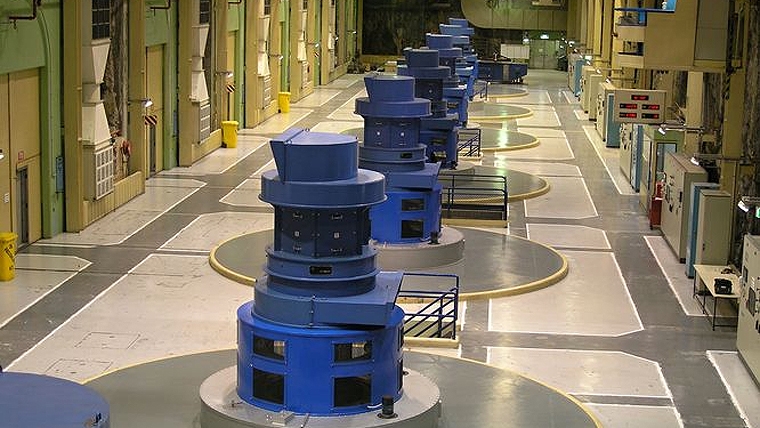
The next stage of the global artificial intelligence (AI) race will be decided not by algorithms or chips, but by electricity – and that puts China at a distinct advantage. While Western tech giants are emphasising closed, capital-intensive models that demand enormous computing power, China is embracing open-source AI and massively expanding its renewable- and nuclear-energy capacity, thereby positioning itself to deploy powerful AI technologies at scale without breaking the bank.
These differences reflect a more fundamental split. Whereas the United States and its allies have treated AI as a proprietary technology, China has approached it as public infrastructure, building an open AI ecosystem that reflects the same philosophy it applied to manufacturing: broad adoption, fast iteration, and relentless cost reduction. Chinese open-source models like DeepSeek, Qwen, and Kimi are not just scientific achievements; they are strategic instruments designed for participation, and they are transforming the economics of AI.
DeepSeek’s latest version reportedly matches the capabilities of frontier systems, like those being developed by US companies, at a fraction of their compute cost. Qwen and Kimi’s API prices have fallen by orders of magnitude. In purely economic terms, the marginal cost of “thought” is collapsing. The inference costs of some Chinese models are a tenth or less of those incurred by OpenAI’s GPT-4.
The cheaper AI becomes, however, the more of it the world consumes, with each token saved inviting a thousand more to be generated. The same dynamic that once powered the coal age now drives the digital one. In China, this is by design: low inference costs, together with the open weights of Chinese models, are intended to invite experimentation across universities, startups, and local governments. But all that activity requires energy: the International Energy Agency expects global electricity consumption from data centres to double by 2030 (from 2024 levels), driven largely by AI workloads. Training GPT-4 alone likely consumed millions of kilowatt-hours – enough to power San Francisco for three days.
What once was a contest of algorithms is fast becoming a contest of kilowatts, and China is setting itself up to win. In 2024, the country added 356 gigawatts of renewable-energy capacity – more than the US, the European Union, and India combined – with 91% of all new generation coming from solar, wind, and hydro. Battery storage tripled from 2021 levels, and an ultra-high-voltage grid now carries clean power thousands of miles, from deserts to data hubs.
China is also investing heavily in nuclear energy. According to the Information Technology and Innovation Foundation, its nuclear research and development spending is roughly five times higher than that of the US. As its fourth-generation reactors and small modular designs advance from pilot to deployment, nuclear energy is quietly providing the baseload power that intermittent renewables cannot.
This combination of open AI models, cheap renewables, and a stable supply of nuclear power forms what might be called an energy-compute flywheel: more clean power enables more compute, which in turn optimises the grid. Already, machine-learning systems are predicting solar output, managing energy storage, and balancing load across China’s vast power network in real time.
The result is a reorganisation of industry, as the traditional boundaries between energy, semiconductors, and software vanish. Data centres are the new power plants; GPUs are the new turbines. China is not merely electrifying its industry; it is electrifying its intelligence.
Beyond strengthening its own clean-energy grid, China is exporting the building blocks of the world’s new energy system. Its clean-tech exports – including solar panels, grid batteries, and electric vehicles – hit a record $20 billion this past August, overtaking its consumer-electronics shipments from a decade earlier. Even if the West exports chips and software, it is China that is producing the electrons that make them useful.
Meanwhile, the West’s energy constraints – aging grids, slow permitting processes, and high prices – are creating digital bottlenecks. In the US and elsewhere, data-centre expansion is increasingly limited by access to a reliable supply of electricity. Some jurisdictions – such as Virginia and Dublin – face moratoria on new data centre.
Industrial revolutions have always favoured the societies that could convert energy into productivity most efficiently. In the 19th century, coal was the key to empire. In the 20th, oil was king. And in the 21st, it will be clean power paired with compute. Whoever commands the cheapest electrons will command the cheapest intelligence – and enjoy growing abundance on both fronts.
China is currently positioning itself to occupy this coveted position, thanks to a systemic alignment of investment and incentives that democracies would find difficult to replicate quickly. But it is not the only country that stands to gain from its success. For emerging economies that have long been priced out of high-performance computing, open-weight models and falling energy costs could make AI accessible and even essential, much like electricity or broadband.
But abundance does not guarantee stability. Without sufficient investment in clean-energy generation and storage, surging energy demand for AI could strain grids and undermine progress on decarbonisation. Like in the industrial age, efficiency could lead to excess, and progress could be accompanied by growing imbalances. Managing the tension between abundance and restraint will determine whether AI becomes a tool of empowerment or a new driver of inequality.
Two centuries ago, the steam engine converted heat into motion – and remade the global economy. Today, AI is transforming electricity into cognition, and whoever masters both will again rewrite the rules of progress.
Jeffrey Wu is Director at MindWorks Capital. This content is © Project Syndicate, 2025, and is here with permission.
4 Comments
Good analysis and detail. How does China fund it's over capacity? How do firms handle the deflationary effects of ever cheaper output?
Apparently Onslow pumped storage is alive and well and going to rely on private equity. The article is paywalled for now but likely to become unpaywalled in a week or so. Maybe they can make more money if they turned it into a supply for AI power and forget the dry year scenario. Earl Bardsley appears to be ecstatic.
Which site could I go and have a look?
The fusion race is on

We welcome your comments below. If you are not already registered, please register to comment.
Remember we welcome robust, respectful and insightful debate. We don't welcome abusive or defamatory comments and will de-register those repeatedly making such comments. Our current comment policy is here.